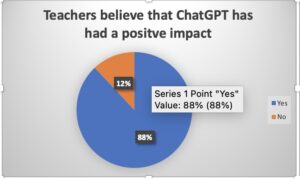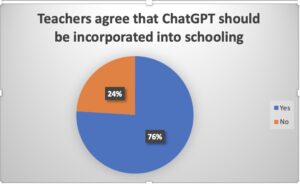To understand how possible it is to incorporate AI search engines into the school curricula and open people’s eyes to their benefits on education, I have decided to examine the policies and opinions on ChatGPT, the most popular AI search engine currently.
Current policies on ChatGPT in the education system
Firstly, it is essential to understand the education system’s current policy on AI search engines in the U.S. From there; we can work to reinforce the support of having sites like ChatGPT as a resource and hopefully help nonsupporters see the error in their ways one day. Below is a map of the current policies on ChatGPT in various states across the U.S.
Data sources from “New York City schools blocked ChatGPT. Here’s what other large districts are doing” and “These Schools and Colleges Have Banned Chat GPT and Similar AI Tools”.
As shown in the map, a couple of cities have already banned the use of ChatGPT in their school districts. Due to ChatGPT’s recent impact on education and everyday life, I could not find a complete data frame with each city’s current policy. Instead, I looked through multiple websites and found that more and more schools are banning ChatGPT every month. As more schools continue to make final policies on ChatGPT, I assume that other school districts will also feel pressure to decide. Schools with ChatGPT bans may not be the majority, but if the benefits of ChatGPT on education are not demonstrated to the undecided schools, then they will soon become the majority. It is also the responsibility of school districts that decided to allow ChatGPT to report their reasoning to help other school districts understand why they should follow suit.
Current teacher opinions on ChatGPT
Next, it is crucial to determine teachers’ opinions on AI search engines and their incorporation into the education system. Teachers should be part of the decision process on ChatGPT policies. School boards may choose whether or not to ban the resources, but if allowed, it’s up to the teachers to determine how to incorporate AI search engines into their classrooms.


Data source from a survey of over 1,000 K-12 teachers.
According to the visualization, most (88%) teachers think ChatGPT positively impacts education. Also, a majority (76%) of teachers agree that ChatGPT should be incorporated into schooling. Although it may not be a consensus among all teachers in the U.S., the survey data was collected by a reputable company (Impact Research). Therefore, it can be safe to assume that most teachers see the benefits of incorporating ChatGPT into their educational curriculum. Additionally, teacher support will win over students and school boards. If the school board sees that teachers genuinely believe in its educational benefits, they will have to side with the teachers. Suppose students see that their teachers genuinely believe in its capabilities and are optimistic about its growing incorporation into daily life. In that case, students will want to learn how to use it to its full capacity.
Current media opinions on ChatGPT
Lastly, it is essential to see how the media portrays ChatGPT’s relationship to education. Where will parents, teachers, and school board members first look for information? That’s right, the news. How the media portrays the relationship can drastically impact the policy decision process on ChatGPT in schools and affect people’s mindsets about ChatGPT. If there were news articles every day only about the consequences of ChatGPT, people would slowly start to view ChatGPT negatively over time. Media can easily sway people’s opinions; therefore, we must examine what the media has stated about ChatGPT and its relationship to education.
Data sources from eleven articles in the New York Times:
The media can significantly impact whether ChatGPT can be added to the educational curriculum. I created this visualization by inserting eleven 2013 New York Times articles about ChatGPT in education to some capacity into Voyant Tools, an online text analysis tool. I then filtered out all the filler words and left the negative and positive words. According to the visualization, there is a slightly positive opinion on the relationship between ChatGPT and education. Words such as “learning” and “help” shed some positive light on the benefits of ChatGPT on education. However, some negative words, like “plagiarism” and “cheating” are inevitable, with the growing idea that students will use ChatGPT to write their assignments instead of using it as a tool. In conclusion, it is the media’s responsibility to report the truth, whether good or bad, which will help in deciding to incorporate ChatGPT into the educational curriculum.